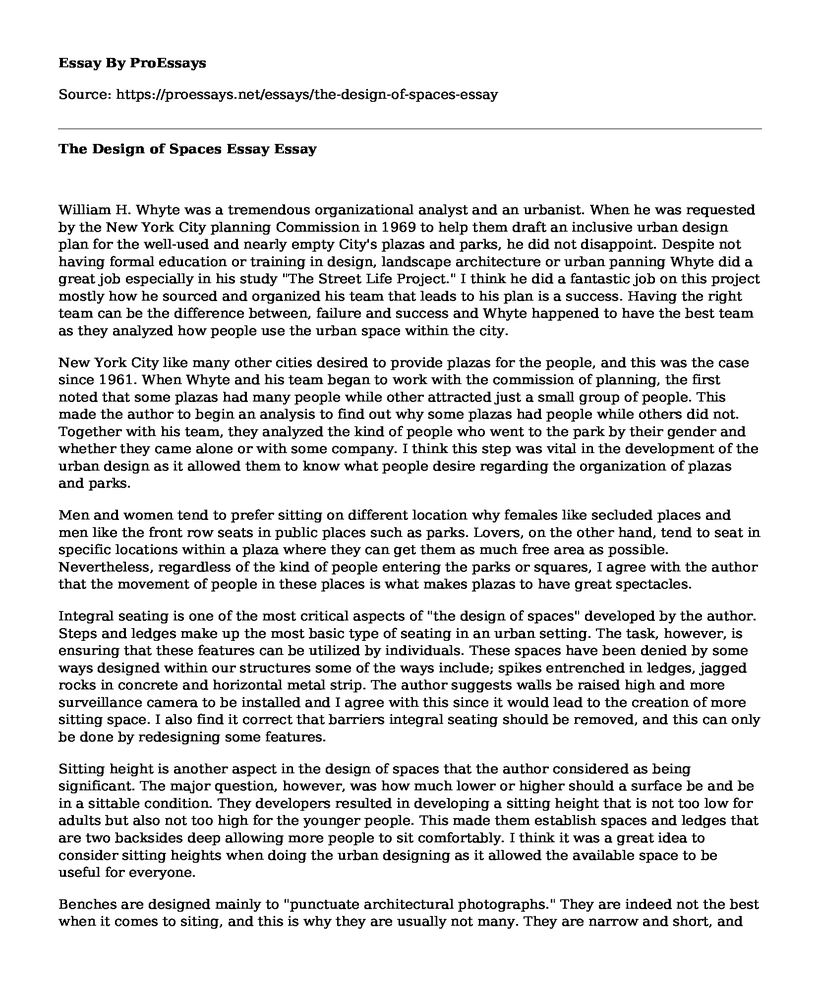William H. Whyte was a tremendous organizational analyst and an urbanist. When he was requested by the New York City planning Commission in 1969 to help them draft an inclusive urban design plan for the well-used and nearly empty City's plazas and parks, he did not disappoint. Despite not having formal education or training in design, landscape architecture or urban panning Whyte did a great job especially in his study "The Street Life Project." I think he did a fantastic job on this project mostly how he sourced and organized his team that leads to his plan is a success. Having the right team can be the difference between, failure and success and Whyte happened to have the best team as they analyzed how people use the urban space within the city.
New York City like many other cities desired to provide plazas for the people, and this was the case since 1961. When Whyte and his team began to work with the commission of planning, the first noted that some plazas had many people while other attracted just a small group of people. This made the author to begin an analysis to find out why some plazas had people while others did not. Together with his team, they analyzed the kind of people who went to the park by their gender and whether they came alone or with some company. I think this step was vital in the development of the urban design as it allowed them to know what people desire regarding the organization of plazas and parks.
Men and women tend to prefer sitting on different location why females like secluded places and men like the front row seats in public places such as parks. Lovers, on the other hand, tend to seat in specific locations within a plaza where they can get them as much free area as possible. Nevertheless, regardless of the kind of people entering the parks or squares, I agree with the author that the movement of people in these places is what makes plazas to have great spectacles.
Integral seating is one of the most critical aspects of "the design of spaces" developed by the author. Steps and ledges make up the most basic type of seating in an urban setting. The task, however, is ensuring that these features can be utilized by individuals. These spaces have been denied by some ways designed within our structures some of the ways include; spikes entrenched in ledges, jagged rocks in concrete and horizontal metal strip. The author suggests walls be raised high and more surveillance camera to be installed and I agree with this since it would lead to the creation of more sitting space. I also find it correct that barriers integral seating should be removed, and this can only be done by redesigning some features.
Sitting height is another aspect in the design of spaces that the author considered as being significant. The major question, however, was how much lower or higher should a surface be and be in a sittable condition. They developers resulted in developing a sitting height that is not too low for adults but also not too high for the younger people. This made them establish spaces and ledges that are two backsides deep allowing more people to sit comfortably. I think it was a great idea to consider sitting heights when doing the urban designing as it allowed the available space to be useful for everyone.
Benches are designed mainly to "punctuate architectural photographs." They are indeed not the best when it comes to siting, and this is why they are usually not many. They are narrow and short, and people must follow specific procedures while sitting on them. I agree that benches should be shortened to provide buffer space and offer a reliable option for those who prefer them.
The movable chair is one invention I found to be magnificent. This is so especially if it has an armrest and a comfortable back. The amazing thing about the movable chair is that it allows people to move closer to their friends or partners and move away or close to the sun or other things that interest them. People feel more confident and comfortable when they know they can move freely. Chair arranging is another factor to consider. I agree with the argument that fixed individual seats can deny choice. As much as they look good in appearance, they are socially uncomfortable and very inflexible.
The grass is another component that can be used as a seat. Though grass is not the most comfortable in terms sitting, I find it true that it is best for Frisbee throwing, picnicking, sunbathing and napping. I also believe grass has several psychological benefits, as it can be much refreshing to seat on since it has no limits, unlike other human-made structures. Additionally, I also agree with the author that the location of the space should be done by considering the connection it has with the community. Without the people, space cannot serve its function. Hence, a good space is one that beckons people in it.
Cite this page
The Design of Spaces Essay. (2022, Apr 15). Retrieved from https://proessays.net/essays/the-design-of-spaces-essay
If you are the original author of this essay and no longer wish to have it published on the ProEssays website, please click below to request its removal:
- Miles Davis Biographical Essay Example
- Scenarios of Social Media Platforms' Managing Paper Example
- Opening Speech
- Analysis of the Film "The Battle of Algiers" Paper Example
- Jean-Antoine Watteau Pastoral Gallery (Fete Galante) - Essay Sample
- Exploring Hip Hop: An Ageless Art Form With Evolving Characteristics - Essay Sample
- Essay Sample on 20th-Century Art: Birth of Modernism and Notable Art Movements







